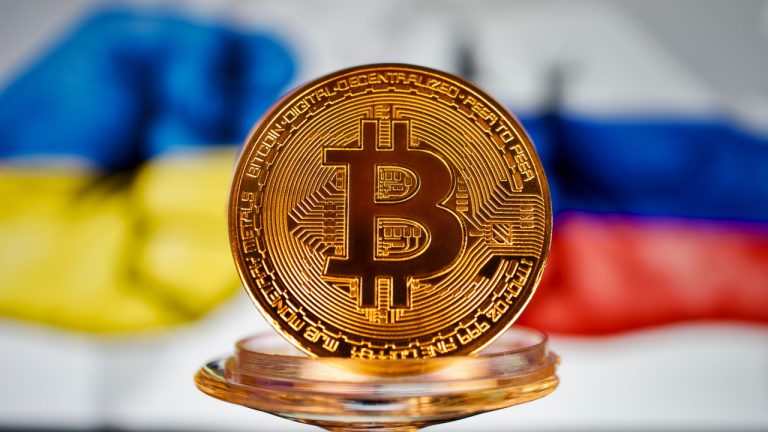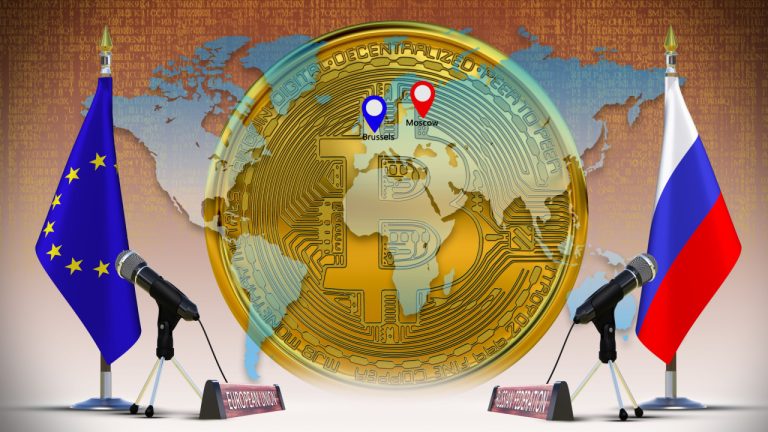 The deadly conflict that started with Russia’s assault on Ukraine has increased crypto-related activity in both countries, according to Chainalysis. Fiat inflation and sanctions pressure led to several spikes in transaction volumes this year, the blockchain forensics firm has found, while Eastern Europe as a whole sustained its role in the global crypto ecosystem. Russians […]
The deadly conflict that started with Russia’s assault on Ukraine has increased crypto-related activity in both countries, according to Chainalysis. Fiat inflation and sanctions pressure led to several spikes in transaction volumes this year, the blockchain forensics firm has found, while Eastern Europe as a whole sustained its role in the global crypto ecosystem. Russians […] The art museum in the Eastern Ukrainian city of Kharkiv has partnered with cryptocurrency exchange Binance to offer non-fungible tokens (NFTs) of some of its most valuable artworks. Proceeds from the auction will be used to restore the museum’s activities and support its staff. Ukrainian Museum to Sell 15 Works of Art as Digital Collectibles […]
The art museum in the Eastern Ukrainian city of Kharkiv has partnered with cryptocurrency exchange Binance to offer non-fungible tokens (NFTs) of some of its most valuable artworks. Proceeds from the auction will be used to restore the museum’s activities and support its staff. Ukrainian Museum to Sell 15 Works of Art as Digital Collectibles […]
The Kharkiv Art Museum launched a new NFT collection on the Binance NFT marketplace to help raise funds for operations and preservation of cultural heritage.
As the Web3 space expands, nonfungible token (NFT) use cases continue to develop past the hyped days of stagnant digital art collections. However, even within the art realm, NFT utility is being reinvented, as is the case with a Ukrainian art museum.
The Kharkiv Art Museum announced on Oct. 13 its “Art without Borders” NFT collection is now available on the Binance NFT marketplace.
It includes 15 pieces of art from the museum’s collection, with proceeds going back to finance the museum and “save the cultural heritage of Ukraine,” as stated by the official announcement.
The museum is one of the oldest in Ukraine, with nearly 25,000 works of fine art by artists from Ukraine and around the world. Artwork by Albrecht Dürer, Georg Jacob Johann van Os, Ivan Aivazovsky, Simon de Vlieger and others is featured in the NFT collection.
Binance NFT head Lisa He told Cointelegraph that in a time of conflict, when donors are looking for a secure and sure way to give funds, NFTs offer reassurance
“[NFTs] offer peace of mind and security for donors because all transactions are registered on blockchain technology. All donations to causes via NFTs are tracked and can’t be altered or deleted."
The Binance exec continued to say that the transparency of the blockchain also allows donors to know when and if funds reached their desired destination.
Related: Museums in the metaverse: How Web3 technology can help historical sites
Museums have utilized NFTs as a means to digitalize art in the past such as the Royal Museum of Fine Arts Antwerp which tokenized a piece in its collection worth millions of euros.
Art has even been NFT-ized in metaverse museums; like when Frida Khalo’s family brought a never-before-seen piece from their private collection into Decentraland.
Meanwhile, the city of Kharkiv has been subject to intense fighting in the ongoing conflict between Ukraine and Russia. Therefore, this collection’s utility can preserve culture currently at risk of being destroyed, which was the case in the infamous looting of the National Museum of Iraq in Baghdad in 2003.
Lisa He says the combination of “nascent NFT technology and the long-standing Ukraine culture heritage in the NFT will support rebuilding culture and history in real life."
Already NFTs have been used as an act of aid and resistance in Ukraine during these turbulent times. Proceeds from an NFT auction were used to help restore physical monuments which have taken damage from the conflict.
The Ministry of Digital Transformation in Ukraine even launched its own digital NFT museum in order to document and preserve a timeline of major events in the conflict.
Lisa He said Binance will continue to support NFT projects that create practical and scalable solutions for various social problems, "including the preservation of Ukraine’s cultural heritage."
 A list of crypto exchanges, including global platforms, have not introduced new restrictions on Russian users after the EU’s most recent sanctions round, Russian crypto media reported. The latest European penalties target an array of crypto-related services to increase pressure on Russia amid an escalating conflict in Ukraine. Major Exchanges Continue to Work in Russia […]
A list of crypto exchanges, including global platforms, have not introduced new restrictions on Russian users after the EU’s most recent sanctions round, Russian crypto media reported. The latest European penalties target an array of crypto-related services to increase pressure on Russia amid an escalating conflict in Ukraine. Major Exchanges Continue to Work in Russia […] The new crypto sanctions imposed by the European Union are likely to spur the development of the country’s digital asset market, according to a Russian lawmaker. Anatoly Aksakov, who chairs the parliamentary Financial Market Committee, believes Russians will manage to bypass the restrictions. Meanwhile, major exchanges have reportedly informed Russian users that trading continues. Russians […]
The new crypto sanctions imposed by the European Union are likely to spur the development of the country’s digital asset market, according to a Russian lawmaker. Anatoly Aksakov, who chairs the parliamentary Financial Market Committee, believes Russians will manage to bypass the restrictions. Meanwhile, major exchanges have reportedly informed Russian users that trading continues. Russians […]
The European Union’s tightening of sanctions on Russian for its continued invasion of Ukraine now includes a ban on all cryptocurrency wallet and custody services. The EU’s eighth package of sanctions comes after new Russian aggressions including annexing four Ukrainian territories in what it calls “sham” referendum votes, calling up additional troops and threatening to […]
The post European Union Tightens Crypto Sanctions on Russia, Bans All Wallet and Custody Services to the Country appeared first on The Daily Hodl.
 An array of crypto-related services have been targeted in the latest round of sanctions on Russia approved by the EU. The measures are part of an expected tightening of the economic and financial restrictions in response to Moscow’s decision to annex Ukrainian territories. EU Council Adopts Full Ban on Crypto Wallet and Custody Services for […]
An array of crypto-related services have been targeted in the latest round of sanctions on Russia approved by the EU. The measures are part of an expected tightening of the economic and financial restrictions in response to Moscow’s decision to annex Ukrainian territories. EU Council Adopts Full Ban on Crypto Wallet and Custody Services for […] Groups supporting Russia’s war effort in Ukraine have been actively collecting cryptocurrency to fund paramilitary operations and evade sanctions, researchers say. According to a new report, these organizations use Telegram to raise money then used to pay for equipment and training. Paramilitary Groups Employ Cryptocurrency to Fund Russian Operations in Ukraine Pro-Russian groups have reportedly […]
Groups supporting Russia’s war effort in Ukraine have been actively collecting cryptocurrency to fund paramilitary operations and evade sanctions, researchers say. According to a new report, these organizations use Telegram to raise money then used to pay for equipment and training. Paramilitary Groups Employ Cryptocurrency to Fund Russian Operations in Ukraine Pro-Russian groups have reportedly […] New sanctions discussed by EU member states amid the current escalation of the conflict in Ukraine are going to restrict European crypto services for Russians. Reports about the tightening have come after earlier this year the Union banned only “high-value” crypto-asset services to Russian residents and companies. EU Expected to Target Crypto Services for Russians […]
New sanctions discussed by EU member states amid the current escalation of the conflict in Ukraine are going to restrict European crypto services for Russians. Reports about the tightening have come after earlier this year the Union banned only “high-value” crypto-asset services to Russian residents and companies. EU Expected to Target Crypto Services for Russians […]
Blockchain combined with decentralized storage could ensure data preservation and anonymity when reporting war crimes.
Human rights investigators appointed by the United Nations (UN) have confirmed war crimes have been committed by Russian forces in Ukraine. A report developed by the Independent International Commission of Inquiry on Ukraine was created in March 2022 to provide a framework for UN human rights investigators to report war crimes in the region.
Erik Møse, chair for the Independent International Commission of Inquiry on Ukraine, stated in the UN’s article that “investigators visited 27 towns and settlements and interviewed more than 150 victims and witnesses.” Møse also noted that “sites of destruction, graves, places of detention and torture, as well as remnants of weapons,” were inspected.
While the report developed by the commission has allowed UN investigators to document war crimes in Ukraine, tools and protocols are still needed to enable individuals to accurately and securely report these acts. Additionally, the need to preserve war crime evidence has become critical as the War in Ukraine enters its seventh month.
Given these challenges, industry experts believe that blockchain technology has the potential to solve many of the issues faced by individuals and organizations documenting war crimes. For example, Jaya Klara Brekke, chief strategy officer at Nym — a platform powered by the Cosmos blockchain that protects the privacy of various applications — told Cointelegraph that Nym is developing a tool known as AnonDrop that will allow users to securely and anonymously upload data. She said:
“The intention is for AnonDrop to become a tool that democratizes the gathering of evidence that can be used to pursue human rights cases. In the current climate in Ukraine, this would be particularly important for the purpose of securely documenting and sharing evidence of war crimes anonymously.”
“The core technology of Nym is a mixnet, which takes data from ordinary users and mixes it together using encryption to make everything look identical. It protects against people watching the network, along with metadata surveillance and IP tracing,” she elaborated. While Nym provides an anonymity layer to allow users to transmit data without revealing who they are, information then gets stored on the decentralized storage network, Filecoin.
Will Scott, a software engineer at Protocol Labs — a company working with Filecoin on its decentralized storage solution — told Cointelegraph that some of humanity’s most important information is stored on Filecoin to ensure that data remains publicly available.
Recent: Are decentralized digital identities the future or just a niche use case?
A blockchain network combined with decentralized storage could be a critical tool for documenting war crimes since it allows individuals in regions like Ukraine to anonymously report, share and retain data. A Wall Street Journal article published in May 2022 stated that “Prosecutors say that, with Russian forces having occupied so much of the country, it is impossible to process all of the evidence of every potential war crime.” Moreover, Ahmed Ghappour, Nym general counsel and associate professor of law at Boston University, told Cointelegraph that it’s becoming critical for witnesses of human rights violations to come forward without fear of retaliation. He said:
“In Ukraine, where witnesses of war crimes are facing a technologically sophisticated adversary, network level anonymity is the only way to guarantee the safety and security needed to provide evidence to prosecute perpetrators.”
Although the potential behind AnonDrop is evident, Klara Brekke noted that the solution is still in its early development stages. “We took part in the Kyiv Tech Summit Hackathon this year hoping to find individuals who could help us extend AnonDrop’s functionality. For instance, AnonDrop’s user interface is not fully up yet and we still need to find a way to verify the authenticity of images uploaded to the network,” she explained.
Ghappour elaborated that verification is the next critical requirement for making sure evidence uploaded to the Nym network can be used in court. “I think one of Russia’s greatest strengths in this war is the region’s ability to deny that any evidence is valid. Russia’s use of deepfakes and misinformation is another strength. We need to guard against these attacks.”
In order to combat this, Ghappour mentioned that image providence features must be implemented within AnonDrop to enable easy verification when documents are examined in a court of law. Even though such processes for image verification currently exist through tools like SecureDrop — a solution that allows individuals to upload photos anonymously for media outlets to use — Ghappour believes that these are limited to siloed organizations.
“We want to take image verification a step further by democratizing the process, ensuring this feature is available to users rather than just media outlets.”
Once image providence is implemented, verifying war crimes could become easier for court officials. Brittany Kaiser, a human rights legal expert, told Cointelegraph that she believes such a tool could help advance the human rights documentation space, where often individuals feel too at risk to submit findings themselves.
“Through images alone, it is possible to verify typical indicators of atrocity crime, including, but not limited to, mass graves, torture marks, binding of hands, executions and other violations of international human rights law that amount to war crimes or other atrocity classifications,” she remarked.
Given the potential for this use case, it shouldn’t come as a surprise that AnonDrop isn’t the only blockchain application focused on the preservation and verification of war crimes. Starling Labs — a Stanford-based research lab focused on data integrity using cryptography and decentralized web protocols — is also using blockchain technology to report war crimes. However, verifying the integrity of data remains the biggest challenge for both Nym and Starling Labs, even with image providence in place.
For instance, Scott pointed out that progress must be made in order to make sure images are legitimate and that verification works well. He further remarked that access to the internet in various regions of Ukraine is censored: “There are distribution questions that are important to consider here.”
Recent: Vietnam’s crypto adoption: Factors driving growth in Southeast Asia
Challenges aside, it’s notable that organizations responsible for prosecuting war crimes are considering using technology to help advance traditional processes. For example, The International Criminal Court (ICC) in The Hague noted in its strategic plan for 2016 to 2018 that it could “support the identification, collection and presentation of evidence through technology.”
The report further noted that the ICC is interested in developing partnerships with non-governmental organizations and academic institutions to facilitate the use of technological advancements for war crime documentation. In the meantime, Ghappour emphasized that Nym will continue to push forward with enabling AnonDrop to be used in regions like Ukraine: “Russia has prolonged wars in the past, so we need to progress with this project no matter what.”